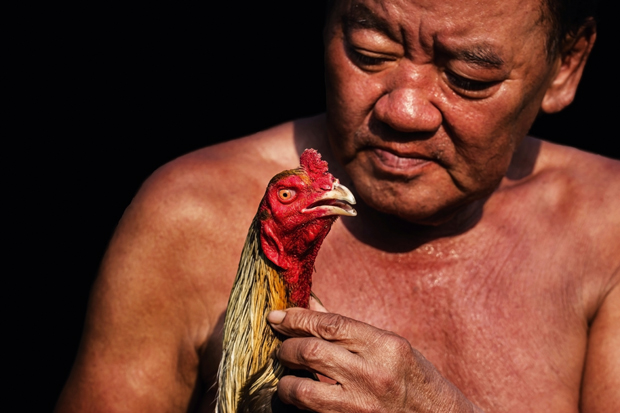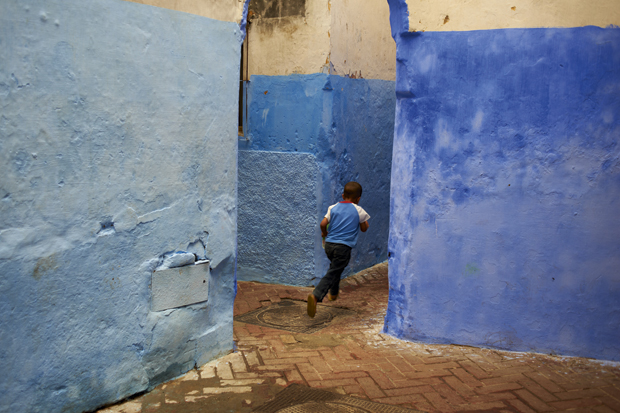Driving around Bali, the first thing I noticed was the big wicker baskets by the roadside. Inside each basket was a cockerel. I asked my friend Wayan why these birds were there. ‘They put them by the road to make them used to people,’ he told me. ‘Then they won’t be scared when it’s time for them to fight.’ ‘What do you mean, time to fight? A cockfight?’ He nodded. Cockfighting is a clandestine activity here. No one talks about it, but those baskets are everywhere.
Cockfighting is an ancient Balinese tradition. The Indonesian government frowns on it, and the heavy gambling that goes with it (men can lose farms on a single fight), but it remains a part of daily life. Cockfights are staged before religious ceremonies, as an offering to the gods. The government forbids cockfights for non-religious purposes, but the government is far away, on Java. Of the 13,000 islands in this archipelago, only Bali is Hindu, and in Bali, cockfighting is performed in every village temple. The people and the government have reached an unspoken compromise: cockfighting can continue, so long as everyone pretends it doesn’t exist.
Yet it does exist, and is thriving. The sheer number of wicker baskets tells you that. Once you’ve seen one, you see them everywhere. People weave them on their doorsteps. They carry stacks of them on motorbikes. It’s the unofficial national sport. Surely this is just as much a part of Bali as all the feel-good stuff?
Bali has learnt to market itself as a new-age nirvana, but this tranquil image isn’t much older than the middle-aged hippies who come here in search of love and peace. For most of its bloody history, it’s had a reputation for violence. The first Dutch colonists who first came here found the Balinese ‘fierce, savage, perfidious and bellicose’. You can hardly blame them for being so unwelcoming. Those Dutchmen had come in search of slaves. Then as now, Balinese women were coveted for their beauty. The men were less highly prized, due to their (understandable) disinclination to obey the white man’s orders.
Despite their overwhelming firepower, it took the Dutch numerous attempts to subdue these natives. They didn’t conquer the island until 1908, whereupon hundreds of Balinese committed mass suicide, which rather took the gloss off the victory parade. This gory spectacle was eclipsed by the bloody civil war of the 1960s, in which about 100,000 islanders were slaughtered. The Balinese have now become famous for their hospitality, but they didn’t have much choice — there’s no money in machismo. Cockfighting feels like the last link with Bali’s warlike past.
After a few false starts (cockfighters are wary of outsiders) I wangled an introduction to a big cockfight a few miles outside Ubud. Ubud is Bali’s cultural capital, where I watched some local girls practising a graceful Balinese Legong dance. The contrast with the cockfight could scarcely have been more stark. As if we were going to an illegal rave, I followed the crowd down a dirt track to an unmarked arena. From the outside it looked like a barn, but inside it was a stadium. Beneath the corrugated iron canopy were four steep terraces around a patch of earth. There were several thousand Balinese men inside — no women and no tourists. The noise of the crowd was shrill, building to a shrieking climax before the beginning of each fight. Men gesticulated wildly, placing bets with fellow punters on opposite sides of the arena in a frenetic semaphore of gestures.
Each cock had fearsome blades strapped to his heels, so the fights were generally brief and bloody, a few seconds of furious activity, a flurry of feathers, then one limp body on the ground and a roar of triumph from half of the baying crowd. If both birds were mortally wounded (which happened several times), the owner of the last bird standing won. Occasionally two cocks had to be forced to fight but usually they needed no encouragement. Their handlers goaded them on by rubbing their beaks together, and gave them the kiss of life when they were wounded, which gave them a brief second wind.
The loser loses more than money. A Balinese man dotes on his fighting cock. It’s a symbol of his virility — the word ‘cock’ is a phallic synonym in Balinese, just as it is in English. It also means hero, warrior, bachelor and ladykiller. To add insult to injury, the winner gets to cook the carcass of the losing bird. This is not just a trophy, but a delicacy — the adrenalin is supposed to enhance the flavour. ‘Chicken curry tonight,’ said the man beside me, with a grin.
After the final fight, I walked to the main road to meet Wayan. I sat and waited as the sun set. I had no idea where I was, and I hadn’t brought my phone. During those ten minutes, I’d never felt more alive, or more alone. ‘As much of America surfaces in a ball park, on a golf links, at a race track, or around a poker table, much of Bali surfaces in a cock ring,’ observed the American anthropologist Clifford Geertz. ‘For it is only apparently cocks that are fighting here. Actually, it is men.’
Got something to add? Join the discussion and comment below.
Get 10 issues for just $10
Subscribe to The Spectator Australia today for the next 10 magazine issues, plus full online access, for just $10.
You might disagree with half of it, but you’ll enjoy reading all of it. Try your first month for free, then just $2 a week for the remainder of your first year.














Comments
Don't miss out
Join the conversation with other Spectator Australia readers. Subscribe to leave a comment.
SUBSCRIBEAlready a subscriber? Log in